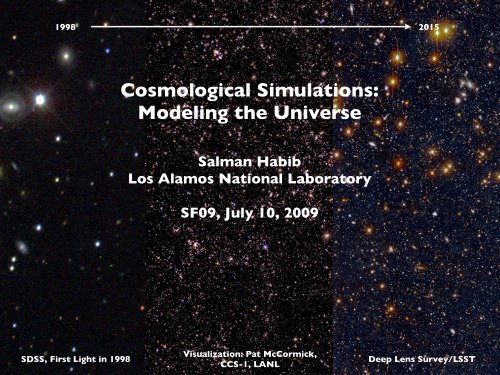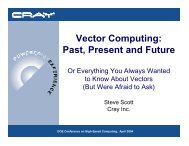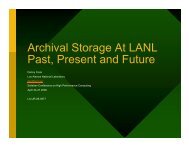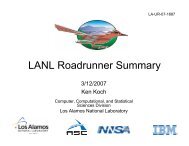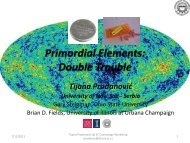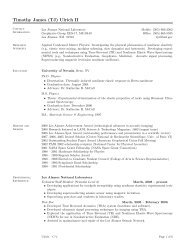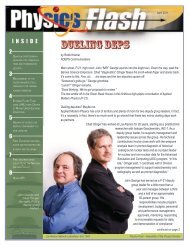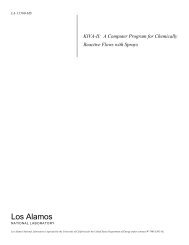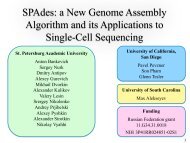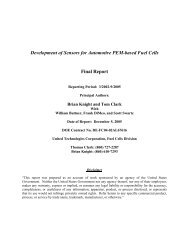Salman Habib - Los Alamos National Laboratory
Salman Habib - Los Alamos National Laboratory
Salman Habib - Los Alamos National Laboratory
You also want an ePaper? Increase the reach of your titles
YUMPU automatically turns print PDFs into web optimized ePapers that Google loves.
1998 2015<br />
Cosmological Simulations:<br />
Modeling the Universe<br />
<strong>Salman</strong> <strong>Habib</strong><br />
<strong>Los</strong> <strong>Alamos</strong> <strong>National</strong> <strong>Laboratory</strong><br />
SF09, July 10, 2009<br />
Visualization: Pat McCormick,<br />
CCS-1, LANL<br />
SDSS, Katrin First Heitmann, Light <strong>Los</strong> <strong>Alamos</strong> in 1998 <strong>National</strong> <strong>Laboratory</strong> Deep Lens LBNL, Survey/LSST<br />
March 12, 2009
Standard Model of Cosmology and Beyond<br />
• Good idea of the history of the Universe<br />
• Good idea of the composition:<br />
‣ ~73% of a mysterious dark energy<br />
‣ ~23% of an unkown dark matter component<br />
‣ ~4% of baryons<br />
• Constraints on ~20 cosmological<br />
parameters, including optical depth,<br />
spectral index, Hubble constant, ...<br />
• Values are known to ~10%<br />
• For comparison: the parameters of the<br />
Standard Model of Particle Physics are<br />
known with 0.1% accuracy!<br />
• Where do we go from here?<br />
‣ Precision for the sake of precision not useful,<br />
want more theory and less phenomenology<br />
‣ Observations and theory must work together to<br />
understand the unknowns of the current<br />
Standard Model<br />
‣ What is the Dark Energy? What is the Dark<br />
Matter? Does GR have to be modified? Where<br />
do the primordial fluctuations come from? How<br />
can inflation be tested? (More physics and<br />
less scenarios)<br />
z~1000<br />
Katrin Heitmann, <strong>Los</strong> <strong>Alamos</strong> <strong>National</strong> <strong>Laboratory</strong> LBNL, March 12, 2009<br />
z~30<br />
z~2
Progress in Cosmology I: CMB<br />
• Cosmic microwave background<br />
measurements started the era of<br />
“precision cosmology”<br />
• What made it “precision”?<br />
‣ Physics “easy” to understand<br />
‣ In its wavelength band, the CMB<br />
dominates the sky<br />
• After CMB, what?<br />
‣ More CMB (polarization), but much<br />
messier!<br />
‣ Large scale structure probes -- but<br />
now must go beyond linear theory<br />
2009+ Planck<br />
Katrin Heitmann, <strong>Los</strong> <strong>Alamos</strong> <strong>National</strong> <strong>Laboratory</strong> LBNL, March 12, 2009
Progress in Cosmology II: LSS<br />
Void<br />
Gregory & Thompson, 1978<br />
• 1978: Discovery of voids and<br />
superclusters, theory of hierarchical<br />
structure formation via gravitational<br />
instability emerges<br />
• 2006: SDSS has measured more than<br />
1,000,000 galaxies, key discoveries such<br />
as BAO (Eisenstein et al.) cementing the<br />
current picture of structure formation<br />
De Lapparent, Geller, Huchra<br />
CfA 1986 1,100 galaxies<br />
SDSS<br />
~1,000,000 galaxies<br />
M. Blanton<br />
Katrin Heitmann, <strong>Los</strong> <strong>Alamos</strong> <strong>National</strong> <strong>Laboratory</strong> LBNL, March 12, 2009
How is Higher Accuracy Useful? Example: Dark Energy<br />
• What is the nature of dark energy?<br />
‣ Cosmological constant (consistent with data, but terrible from theoretical perspective)<br />
‣ Scalar field (foundational motivation is fuzzy, but good toy models for a dynamical explanation)<br />
‣ Phase transition of some sort?<br />
‣ Or perhaps general relativity needs modification at large length scales?<br />
• All alternatives less than compelling (1000+ papers! No one believes anyone else,<br />
including themselves. Anyway, how can any sane person test so many models?)<br />
• Settle, therefore, for a more model-free approach. Try to determine the dark energy<br />
equation of state, w and its time variation (Cosmological const. has w=-1, dw/dt=0)<br />
• Ask question such as, can we exclude classes of dark energy models? Can we carry<br />
out consistency tests to show that GR works as well in cosmology as on sub-galactic<br />
scales? Rule out more whacky ideas --<br />
• CMB provides very useful information, with good control on systematic errors. But to<br />
move forward need structure formation probes: baryon acoustic oscillations<br />
(geometry), cluster counts (mass function), supernovae (geometry), weak lensing<br />
(mass distribution). These are promising, but intrinsically complex!<br />
• Can even the minimal program be carried out? Observers are confident --<br />
• Can theorists afford to be complacent? There’s more to life than forecasts! (See<br />
Decadal Survey White Papers) Plenty of examples where theory is stuck (foundations<br />
of turbulence, nonperturbative dynamics of field theories, --)<br />
Katrin Heitmann, <strong>Los</strong> <strong>Alamos</strong> <strong>National</strong> <strong>Laboratory</strong> LBNL, March 12, 2009
Future of Precision Cosmology<br />
• Current coss-validated Standard Model<br />
works at better than 10%, so --<br />
‣ It’s unlikely that whatever comes next will<br />
totally overthrow what is currently known.<br />
For two reasons: (i) What we know is pretty<br />
solid, and (ii) Mostly we are pushing<br />
observational boundaries not so much creating<br />
new windows to observe the Universe (e.g.,<br />
gravitational waves, neutrino telescopes)<br />
‣ Signatures of new physics will be subtle,<br />
otherwise they would have been picked up<br />
already<br />
‣ Can theoretical predictions be made<br />
accurately enough? Can systematic errors<br />
be controlled to the desired levels?<br />
• How good is analytic theory?<br />
‣ No natural expansion parameter, breaks<br />
down catastrophically in nonlinear regime<br />
‣ Cannot deal with complexity of the problem<br />
• Are simulations up to the challenge?<br />
‣ Extreme dynamic range<br />
‣ All relevant physics hard to include<br />
Carlson, White, Padmanabhan 2009<br />
Simulations<br />
One-loop<br />
pertbn. theory<br />
Two-loop<br />
pertbn. theory<br />
Linear theory<br />
Heitmann et al 2009<br />
Katrin Heitmann, <strong>Los</strong> <strong>Alamos</strong> <strong>National</strong> <strong>Laboratory</strong> LBNL, March 12, 2009
What do Simulations do?<br />
• At large scales, gravity dominates, so<br />
need to solve the Einstein-Poisson<br />
equation in the non-relativistic limit<br />
‣ Note equation is (i) 6-D, and (ii)<br />
intrinsically nonlinear, cannot solve<br />
as PDE<br />
‣ Use N-body methods -- sample<br />
phase-space PDF with particles and<br />
evolve system of interacting particles<br />
‣ Can we understand and predict errors<br />
well enough?<br />
• At small scales need to add gas<br />
physics (hydrodynamics) and<br />
astrophysical feedback<br />
‣ Simulations get harder --<br />
‣ Gastrophysics too complicated<br />
(subgrid modeling needed)<br />
‣ Need to calibrate simulations against<br />
observations. Is this doable?<br />
Cosmological Vlasov-Poisson Equation<br />
Simulated Sky<br />
Real Sky (SDSS)<br />
Katrin Heitmann, <strong>Los</strong> <strong>Alamos</strong> <strong>National</strong> <strong>Laboratory</strong> LBNL, March 12, 2009
Life with a Gravity-only Cosmology Code (Cartoon)<br />
• Initial Conditions<br />
‣ Simulation begins with initial density field well in the linear regime. (i) Pick primordial<br />
power spectrum; (ii) Multiply by transfer function for chosen cosmology; (iii) Normalize as<br />
desired (CMB or LSS); (iv) Generate a single realization of the density field in k-space,<br />
use Poisson equation to solve for gradients of the potential field; (v) use Zel’dovich (or<br />
some other) approximation to move particles off a grid (quiet start) or off a “glass” initial<br />
configuration<br />
• Time-Stepping<br />
‣ Use symplectic/leap-frog integrator; first “stream” particles, then compute inter-particle<br />
forces, update velocities, do next “stream” and repeat ad nauseam --<br />
‣ More sophistication -- adaptive/individual particle time-steps, particle splitting, etc.<br />
• Force Computation<br />
‣ Direct particle-particle force evaluations hopeless, use approximate tricks (tree, PM,<br />
AMR, --) to reduce order of algorithm to NlogN<br />
• Tests<br />
‣ Many sources of error in places you don’t expect; develop suite of tests for robustness of<br />
simulation results, check everything multiple times --<br />
• Analysis<br />
Katrin ‣ Compute P(k), etc. Make halo catalogs, merger trees -- write papers<br />
Heitmann, <strong>Los</strong> <strong>Alamos</strong> <strong>National</strong> <strong>Laboratory</strong> LBNL, March 12, 2009
Large Scale Structure Probes: Some Numbers<br />
P(k)<br />
Baryon Wiggles<br />
k [h/Mpc]<br />
6Gpc Box<br />
Vikhlinin et al. 2008,<br />
ApJ in press<br />
• Baryon Accoustic Oscillations (BOSS, HETDEX, JDEM, LSST,<br />
WiggleZ, --)<br />
‣ Precision requirement: 0.1% measurement of distance scale<br />
‣ Simulations: Very large box sizes (~3 Gpc) to reduce sampling<br />
variance and systematics from nonlinear mode coupling<br />
‣ Gravity-only simulations largely adequate<br />
• Weak Lensing (Euclid, JDEM, LSST, --)<br />
‣ Precision requirement: 1% accuracy at k~1-10 h/Mpc<br />
‣ Large box sizes (~1Gpc) to reduce nonlinear mode coupling<br />
‣ At scales k > 1 h/Mpc: baryonic physics starts to become important<br />
• Clusters (eROSITA, LSST, SPT, --)<br />
‣ Large box sizes (~1Gpc) for good statistics (~40,000 clusters)<br />
‣ Gas physics and feedback effects important<br />
‣ Well calibrated mass-observable relations required<br />
Katrin Heitmann, <strong>Los</strong> <strong>Alamos</strong> <strong>National</strong> <strong>Laboratory</strong> LBNL, March 12, 2009
“Great Survey” Size Simulations<br />
• Workhorse “Billion/Billion” simulation:<br />
‣ Gigaparsec box, billion particles<br />
‣ Smallest halos: ~10¹³ M . (100 particles)<br />
‣ 10 time snapshots: ~250GB of data<br />
‣ ~30,000 Cpu hours with e.g. Gadget-2, ~5<br />
days on 256 processors (no waiting time in the<br />
queue included...)<br />
‣ Accuracy at k~1h/Mpc: ~1%<br />
• “Supersimulations” 1-6 Gpc, 300 billion to<br />
one trillion particles<br />
‣ Smallest dark matter halos: ~10¹² M .<br />
(and<br />
10-100 times smaller --)<br />
‣ 10 time snapshots: ~75TB (for 300 billion<br />
particles)<br />
• Effectively one wants to model the entire<br />
observable Universe down to galactic<br />
scales!<br />
‣ Basic gravity runs must satisfy stringent error<br />
requirements<br />
‣ Addition of new physics -- non-Gaussianities,<br />
modified gravity, self-consistent dark energy,<br />
dark energy fluctuations, etc. -- must also<br />
satisfy the same requirements<br />
Katrin Heitmann, <strong>Los</strong> <strong>Alamos</strong> <strong>National</strong> <strong>Laboratory</strong> LBNL, March 12, 2009
Cosmological Simulations: More on Requirements<br />
I. Techniques:<br />
N-body treatment of gravity in an<br />
expanding universe including gas<br />
dynamics and subgrid physics (star<br />
formation, supernova feedback, etc.)<br />
II. Large vs. Small:<br />
Large simulations cover entire survey<br />
volumes, smaller simulations target<br />
physics issues at enhanced resolution<br />
II. Requirements:<br />
(1) Memory, (2) Dynamic range in<br />
space, time, and mass, (3) Accuracy<br />
and robustness, and (4) Speed<br />
current “workhorse”<br />
simulations (billion<br />
particles)<br />
Example: SDSS-III, Gravity-only (need many of these)<br />
Volume = 3 (Gpc)^3, Memory ~ 40 TB (particles + grid)<br />
Particle mass = 10^10 Solar mass, # of particles, N > 3X10^11<br />
Force resolution, ∆ = 30 kpc (or less), Spatial dynamic range = 10^5-10^6<br />
Mass dynamic range = 10^4 -10^5, Time-steps ~ 10^4-10^5<br />
Example requirement -- galaxy clustering statistics to accuracy of better than 1%
The Coyote Universe: Walking before Running<br />
Coyote-I: arXiv:0812.1052, Coyote-II: arXiv:0902.0429 (ApJ, to appear),<br />
Coyote-III, IV: in preparation, and even more to come --<br />
• Large simulation suite run on LANL Coyote compute cluster<br />
‣ 38 cosmological models with different dark energy equations of state<br />
‣ 1.3 Gpc cubed comoving volume, 1 billion particles each<br />
‣ 16 medium resolution, 4 higher resolution, and 1 very high resolution simulation for each model<br />
= 798 simulations, ~60Tb of data<br />
• Aim: precision predictions at the 1% accuracy level (really) for different<br />
cosmological statistics<br />
‣ dark matter power spectrum out to k~1h/Mpc; on smaller scales: hydrodynamics effects<br />
become important! (White 2004, Zhang & Knox 2004, Jing et al. 2006, Rudd et al. 2008)<br />
‣ weak lensing shear power spectrum<br />
‣ halo mass function<br />
• Three parts to the project:<br />
‣ Demonstrate 1% accuracy of the dark mattter simulations out to k=1h/Mpc ✓ (arXiv:0812.1052)<br />
‣ Develop framework which can predict these statistics from a minimal number of simulations ✓<br />
(arXiv:09.02.0429)<br />
‣ Build prediction tools from simulation suite (Coyote III, IV, in progress)<br />
Katrin Heitmann, <strong>Los</strong> <strong>Alamos</strong> <strong>National</strong> <strong>Laboratory</strong> LBNL, March 12, 2009
P(k)[(Mpc/h) 3 ]<br />
Code Comparison: Are the Basic Techniques Robust?<br />
Residuals<br />
10000<br />
1000<br />
100<br />
Heitmann et al., ApJS (2005); Heitmann et al., Comp. Science and Discovery (2008)<br />
10<br />
1<br />
0.1<br />
0.05<br />
0<br />
-0.05<br />
HOT<br />
PKDGRAV<br />
Hydra<br />
Gadget-2<br />
TPM<br />
TreePM<br />
0.1 1 10<br />
k[h/Mpc]<br />
64 Mpc/h<br />
256³ particles<br />
Particle<br />
Nyquist<br />
• Comparison of ten major<br />
codes (subset is shown)<br />
• Each code starts from<br />
same initial conditions<br />
• Each simulation is<br />
analysed in exactly the<br />
same way<br />
• Overall, good agreement<br />
between codes for<br />
different statistics at the<br />
5-10% level<br />
Katrin Heitmann, <strong>Los</strong> <strong>Alamos</strong> <strong>National</strong> <strong>Laboratory</strong> LBNL, March 12, 2009<br />
2%<br />
?<br />
Flash<br />
PKDGRAV
Mass Resolution: Technical Issues Matter!<br />
• How many particles needed? Test<br />
with different particle loading in 1Gpc<br />
box<br />
‣ Run 1024³ particles as reference<br />
‣ Downsample to 512³ and 256³ particles<br />
and run forward<br />
‣ In addition: downsample z=0,1 1024³<br />
results to characterize shot noise<br />
problem<br />
• For precision answers, interparticle<br />
spacing has to be small! Previous<br />
hand-waving arguments and folk<br />
theorems incorrect<br />
• Requirement: k < k_Ny/2 (no surprise<br />
to Shannon)<br />
• Gigaparsec box requires billion<br />
particle minimum, thus a factor of 10<br />
increase in resolution will require a<br />
trillion particles!<br />
• Force resolution is not the limiting<br />
factor, but mass resolution is<br />
256³ particles k_Ny/2<br />
512³ particles<br />
Katrin Heitmann, <strong>Los</strong> <strong>Alamos</strong> <strong>National</strong> <strong>Laboratory</strong> LBNL, March 12, 2009<br />
z=1<br />
z=0<br />
Downsampled<br />
to 512³<br />
Downsampled<br />
to 256³
How Many Simulations?: Cosmic Calibration<br />
Heitmann et al., ApJL (2006); <strong>Habib</strong> et al., PRD (2007); Schneider et al., PRD (2008),<br />
Heitmann et al., arXiv:0902.0429<br />
• Good News: We have simulation accuracy under control at the 1% level out to<br />
k~1h/Mpc<br />
‣ Mass resolution, box size, initial start, force resolution, and time step criteria exist!<br />
• Bad News: For cosmological constraints from e.g. SDSS:<br />
‣ Run your favorite Markov Chain Monte Carlo code, eg. CosmoMC<br />
- MCMC: directed random-walk in parameter space<br />
‣ Need to calculate P(k) ~ 10,000 - 100,000 times for different models<br />
‣ 30 years of Coyote time (2048 processor Beowulf Cluster), impossible!<br />
• What we need: framework that allows us to provide, e.g., P(k) for a range of<br />
cosmological parameters via some form of “interpolation”<br />
• The Cosmic Calibration Framework (based on several cutting edge<br />
applications of modern statistics) provides:<br />
‣ Simulation design, an optimal strategy to choose parameter settings<br />
‣ Emulation, smart interpolation scheme that will replace the simulator and will generate<br />
power spectra, mass functions... with controlled errors<br />
‣ Uncertainty and sensitivity analysis<br />
‣ Calibration -- combining simulations with observations to determine best-fit cosmology<br />
Katrin Heitmann, <strong>Los</strong> <strong>Alamos</strong> <strong>National</strong> <strong>Laboratory</strong> LBNL, March 12, 2009
P(k) Emulator Performance: Proof of Success<br />
• Emulator: interpolation scheme, which allows us to predict the power spectrum at<br />
non-simulated settings in the parameter space under consideration<br />
• Build emulator from 37 HaloFit runs according to our design<br />
• Generate 10 additional power spectra within the priors with Halofit and the emulator<br />
• Emulator predictions are accurate at the sub-percent level!<br />
• Removes fundamental barrier to precision simulation approach<br />
Katrin Heitmann, <strong>Los</strong> <strong>Alamos</strong> <strong>National</strong> <strong>Laboratory</strong> LBNL, March 12, 2009<br />
1%<br />
1%
The Next Step: The Roadrunner Universe<br />
hard to refuse, eh?<br />
The nuts and bolts, a year and a half later --<br />
Katrin Heitmann, <strong>Los</strong> <strong>Alamos</strong> <strong>National</strong> <strong>Laboratory</strong> LBNL, March 12, 2009
6GB<br />
6GB<br />
100TB total RAM<br />
Opterons have little compute,<br />
but half of the memory and<br />
balanced communication<br />
Cells dominate the compute<br />
but communication is poor,<br />
50-100 times out of balance<br />
Multi-layer programming<br />
model<br />
What is Roadrunner?<br />
PPU<br />
4XSPE<br />
4XSPE<br />
Bus<br />
C/SPU<br />
Intrinsics<br />
DaCS<br />
C/C++<br />
MPI<br />
Notional Cell Architecture<br />
RAM<br />
I/O
How to make Roadrunner a Cosmic Predictor?<br />
• Direct N-body O(N^2)<br />
‣ Accurate, but hopeless -- 100 years on Roadrunner! (too long by a factor of 10,000)<br />
• Grid-based methods (PIC/PM) O(NlogN)<br />
‣ Fast, good error controls but memory-limited due to the grid, would require 10-100 PB to<br />
reach dynamic range target (too big by about a factor of 1000)<br />
• PIC/PM + Adaptive Mesh Refinement (AMR)<br />
‣ Too slow, complex, memory problems persist, error controls a worry<br />
• Tree Methods O(NlogN)<br />
‣ Efficient, but boundary conditions and error controls troublesome, performance controlled<br />
by tree-walk<br />
• Hybrid I: Tree/PM<br />
‣ Long/medium range force handled by PM, short range forces via tree, involves dealing<br />
with a complicated data structure, error control still an issue?<br />
• Hybrid II: P^3M<br />
‣ Long/medium range force handled by PM, short range forces via direct N^2. Easy to<br />
code, error control is simple, but can bog down when particle distribution is clustered<br />
Katrin Heitmann, <strong>Los</strong> <strong>Alamos</strong> <strong>National</strong> <strong>Laboratory</strong> LBNL, March 12, 2009
Back of the Envelope MC3 Design I<br />
Hybrid grid/particle design is good match to RR architecture:<br />
Grid on Opteron layer, “standard” operations (FFTs, shifts,<br />
etc.), handle medium-resolution tasks (~40s/10^4 cubed FFT)<br />
Particles on Cell layer, which handles compute-intensive high<br />
resolution tasks (similar memory requirements as grid)<br />
Limited inter-layer BW not a problem as only grid info goes<br />
back and forth between layers (requires ~1s) and only<br />
intermittently (need ~100-1000 long time-steps)<br />
Which hybrid design?<br />
Opted for P^3M -- clustering problem overcome by brute<br />
force Cell performance (100 GF/s/CBE ok for 10^5 particles/<br />
CBE, worst case, O(secs)) -- applies to large volume cosmology<br />
simulations (single precision, local coordinates -- whew!), no<br />
need to load balance (large physical volume/node)<br />
Conclusion:<br />
Simple performance estimates argue that base code can run the<br />
reference simulation problem in a matter of days, provided that<br />
scaling can be achieved (is this a big if? -- Cell comm BW is poor)
• Use P^3M<br />
‣ Grid lives on Opteron layer with FFT Poissonsolves<br />
of up to 10,000^3, uses digital filtering<br />
and Super-Lanczos differentiation to reduce<br />
particle-grid interaction<br />
‣ Particles live in Cell BE and interact on “subgrid<br />
scales” by fast hand-coded routines<br />
‣ Only simple grid info flows between Cells and<br />
Opterons, so thin pipe problem is solved<br />
• Avoid Particle Communication<br />
‣ Particle communication between Cells at<br />
every short-range step would be too slow,<br />
avoid this using particle caching<br />
‣ Intermittent nearest neighbor refresh (fast)<br />
• On the Fly Analysis<br />
‣ Avoid I/O as much as possible, analysis<br />
routines must run as a part of the code Overload Zone (particle “cache”)<br />
Nodal domain contains all particles that will ever cross into its reference volume (30% overhead can be reduced to few %). Particles<br />
inside reference volume are “active”, i.e., used to compute self-consistent force, others are “passive”, i.e., used only as tracers (their<br />
“active” self belongs to a different compute node); as they move, particles change their state based on local information. For the PM<br />
piece, overloading is “exact”, for the N^2 part, error at the domain edge propagates inwards. But it is (i) small, and (ii) can be controlled<br />
by increasing Katrin Heitmann, the boundary <strong>Los</strong> <strong>Alamos</strong> layer <strong>National</strong> thickness <strong>Laboratory</strong> or via periodic refreshes.<br />
LBNL, March 12, 2009
P^3M requires “quiet” force<br />
at hand-over:<br />
Spatial filtering (TSC<br />
etc.) too complex for Cell<br />
Spectral filtering in Fourier<br />
domain reduces code “bookkeeping”:<br />
Use basic CIC deposition<br />
and interpolation at the<br />
Cell level<br />
Apply spectral filtering<br />
at Opteron (grid) level<br />
-- as effective as spatial<br />
filtering<br />
Avoid real-space<br />
differentiation by using<br />
the super-Lanczos<br />
gradient (see Hamming)<br />
Not BOE Design MC3 III<br />
!"#+<br />
!"#*<br />
!"#)<br />
!"#(<br />
!"#'<br />
!"#&<br />
!"#%<br />
!"#$<br />
!"<br />
!" !$ !% !& !' !( !) !* !+<br />
!(#$<br />
!(<br />
!"#'<br />
!"#&<br />
!"#%<br />
!"#$<br />
CIC PM<br />
1/r^2<br />
Noisy CIC PM force<br />
6th-Order sinc-Gaussian<br />
filtered CIC PM force<br />
“Quiet” PM<br />
Ratio to 1/r^2<br />
!"<br />
!" !( !$ !) !% !* !& !+ !'
The Roadrunner Universe Project: Status<br />
Collaboration: S. <strong>Habib</strong> (PI), J. Ahrens, L. Ankeny, S. Bhattacharya, J. Cohn,<br />
C.-H. Hsu, D. Daniel, N. Desai, P. Fasel, K. Heitmann, Z. Lukic, G. Mark, A. Pope, M. White<br />
• First full test code (med.<br />
resolution) to run anytime now,<br />
will already be the largest<br />
cosmology run ever (~100+<br />
billion particles)<br />
• First high resolution runs in a<br />
month (particle-particle force is<br />
>50 times faster on the Cells wrt<br />
the Opterons)<br />
• Hydro module in the fall<br />
• Roadrunner Universe Blue<br />
Book soon(ish)<br />
• Data will be made public (as<br />
much as size limitations allow)<br />
Katrin Heitmann, <strong>Los</strong> <strong>Alamos</strong> <strong>National</strong> <strong>Laboratory</strong> LBNL, March 12, 2009
The Roadrunner Universe Project: Science<br />
• SDSS-III/BOSS baryon acoustic oscillations simulations and mock catalogs<br />
• SDSS-III Lyman-alpha runs, signature of BAO scale in Lyman-alpha forest<br />
• JDEM weak lensing<br />
• High-resolution simulations for dark matter searches<br />
• LSST simulations for a variety of projects (weak lensing, clusters, BAO)<br />
• Large-volume cluster simulations and large-scale flows<br />
• Addition of new physics:<br />
‣ Self-consistent dark energy models and inclusion of dark energy fluctuations (LSST ISW)<br />
‣ Nonparametric w(z) simulations<br />
‣ Calibration of baryonic effects in weak lensing<br />
‣ New code for modified gravity (cosmological PPN)<br />
‣ More general primordial fluctuations (running of spectral index, non-Gaussianity, warm/nonthermal dark<br />
matter)<br />
‣ Nonlinear clustering of neutrinos<br />
‣ Your favorite idea here --<br />
• Extension of Calibration Framework to address expanded “physics space” and smaller<br />
errors<br />
Katrin Heitmann, <strong>Los</strong> <strong>Alamos</strong> <strong>National</strong> <strong>Laboratory</strong> LBNL, March 12, 2009
Conclusions<br />
• Nonlinear regime of structure formation requires simulations<br />
‣ No error controlled analytic theory exists or is ever likely to exist<br />
‣ Simulated skies/mock catalogs essential for survey analysis and accurate predictions<br />
• Simulation requirements are demanding, but (at least some) can be met<br />
‣ Only a finite number of simulations need be performed (will always be true?)<br />
‣ Hydro/feedback calibration against data is key, we have a method to do this within the<br />
CCF<br />
• Cosmic Calibration Framework<br />
‣ Accurate emulation of several statistics, matching within code errors<br />
‣ Allows (very) fast calibration of models vs. data<br />
• Future simulations<br />
‣ Very large data sets<br />
‣ Emphasis on analysis, what should be done<br />
‣ How should data be made available to the community? (RRU will have a ~PB of data)<br />
Katrin Heitmann, <strong>Los</strong> <strong>Alamos</strong> <strong>National</strong> <strong>Laboratory</strong> LBNL, March 12, 2009


